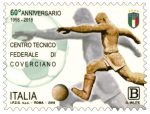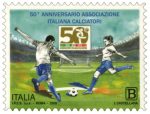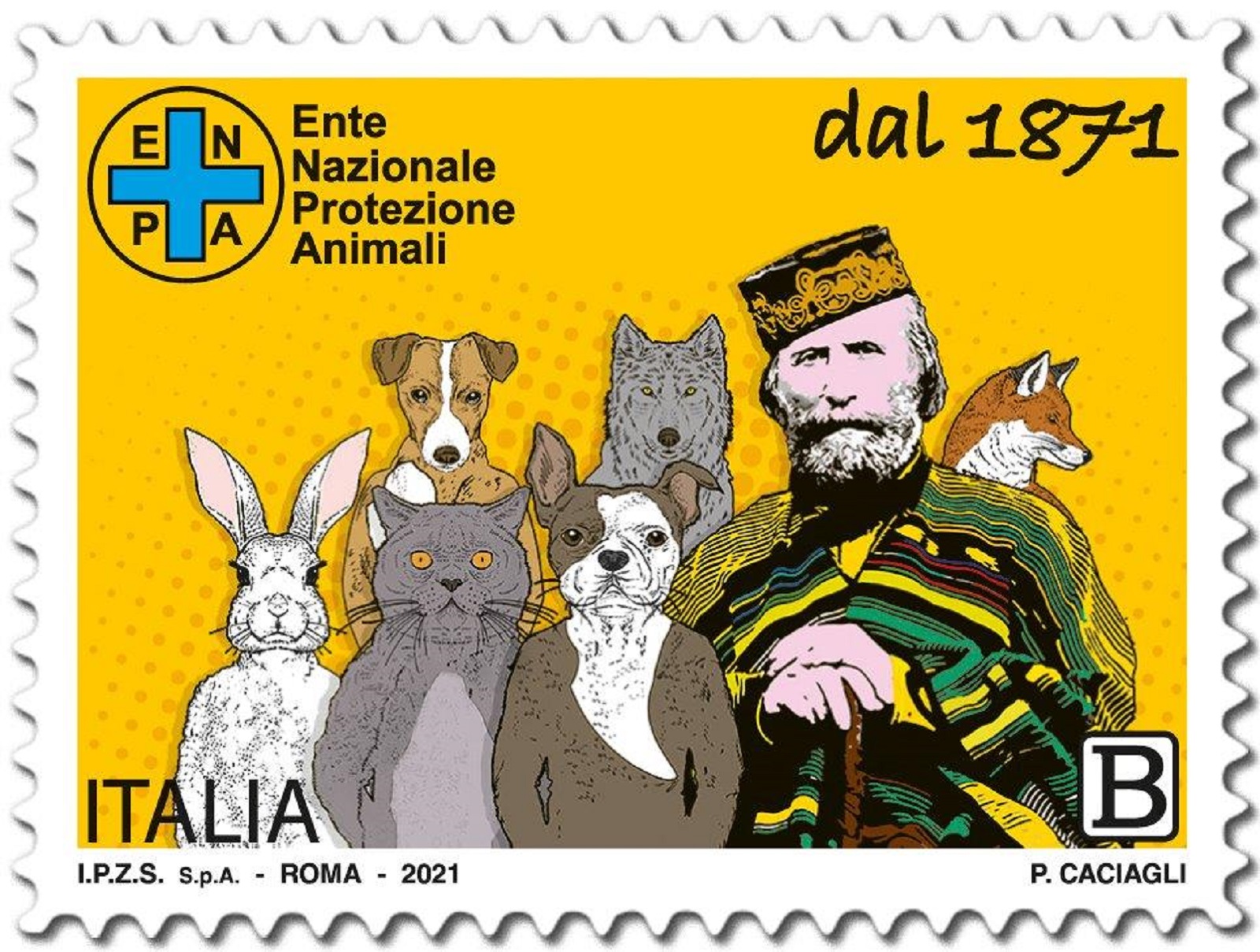POSTE ITALIANE – 38^ Emissione del 12 Novembre 2018 dedicati al 60° anniversario del Centro Tecnico Federale di Coverciano e al 50° anniversario dell’Associazione Italiana Calciatori della fondazione
Titolo: 60° Anniversario della fondazione del Centro Tecnico Federale di Coverciano

Titolo: 50° Anniversario della fondazione dell’Associazione Italiana Calciatori
Il Ministero dello Sviluppo e le Poste Italiane hanno emesso il 12 novembre 2018 due francobolli ordinari appartenenti alla serie tematica “lo Sport” dedicati al Centro Tecnico Federale di Coverciano e all’Associazione Italiana Calciatori, rispettivamente nel 60° e nel 50° anniversario della fondazione, relativi al valore della tariffa B.
Il Centro Tecnico Federale “Luigi Ridolfi” è la sede del settore tecnico della Federazione Italiana Giuoco Calcio e dei ritiri delle rappresentative nazionali italiane. Ha sede a Firenze, nel quartiere di Coverciano, ragion per cui vi si fa colloquialmente riferimento come Centro Tecnico di Coverciano o ancor più brevemente solo come Coverciano, passato a indicare per antonomasia il ritiro della nazionale A. Il centro nasce nel 1959 per volontà di Luigi Ridolfi e Dante Berretti. All’interno ospita dal 2000 anche il Museo del calcio.
Storia
Il Centro Tecnico Federale (CTF) prese vita grazie al Marchese Luigi Ridolfi, al quale l’impianto fu dedicato dopo la scomparsa nel 1958, e a Dante Berretti, presidente della IV Serie dal 1952 al 1959 e successivamente vicepresidente della Lega, al quale dopo la scomparsa nel 1965, verrà intitolato il Campionato nazionale Dante Berretti. A distanza di circa un anno cominciarono i lavori, che furono ultimati nell’ottobre 1957: la progettazione fu a opera degli architetti Francesco Tiezzi e Arnaldo degli Innocenti. Il 6 novembre 1958, alla presenza del commissario straordinario della Federcalcio, Bruno Zauli, l’impianto fu inaugurato.
Il Marchese Ridolfi ideò il Centro rendendolo polifunzionale, puntando sul calcio ma senza tralasciare le altre discipline; pertanto nell’impianto sorsero una piscina, una pista d’atletica e una palestra. Nel 1974 venne istituito il Reparto Medico, denominato Sezione Medica dal 1983; tale sezione ha il compito di sovrintendere all’organizzazione sanitaria della Federazione. Nel 1977 venne istituita una sezione per lo sviluppo e la promozione del Nucleo Addestramento Giovani Calciatori, rinominata Sezione per lo Sviluppo del Calcio Giovanile e Scolastico dal 1983.
Dall’inaugurazione a oggi il Centro Tecnico è divenuto la sede per i raduni, le selezioni e gli allenamenti della nazionale A, dell’Under 21 e di tutte le altre rappresentative giovanili, della nazionale militare, della nazionale di calcio a 5 e della nazionale femminile.
Federal Technical Center of the Italian Football Association
The Federal Technical Center “Luigi Ridolfi” is the headquarters of the technical sector of the Italian Football Federation and of the Italian national representatives’ retreats. It is based in Florence, in the district of Coverciano, which is why it is colloquially referred to as the Technical Center of Coverciano or even more briefly as Coverciano, passed to indicate by antonomasia the withdrawal of the national A. The center was founded in 1959 by the will of Luigi Ridolfi and Dante Berretti. Inside, it has also hosted the Football Museum since 2000.
History
The Federal Technical Center (CTF) came to life thanks to the Marquis Luigi Ridolfi, to whom the plant was dedicated after his death in 1958, and to Dante Berretti, president of the IV Series from 1952 to 1959 and subsequently vice-president of the Lega, to whom disappeared in 1965, the Dante Berretti National Championship will be named. A year or so began the work, which was completed in October 1957: the design was carried out by the architects Francesco Tiezzi and Arnaldo degli Innocenti. On November 6, 1958, in the presence of Federcalcio’s extraordinary commissioner, Bruno Zauli, the plant was inaugurated.
The Marquis Ridolfi conceived the Center by making it multi-functional, focusing on football but without neglecting other disciplines; therefore in the plant a swimming pool, an athletic track and a gym arose. In 1974 the Medical Department was established, named Medical Section since 1983; this section has the task of overseeing the Federation’s health organization. In 1977 a section was set up for the development and promotion of the Young Players Training Team, renamed the Section for the Development of Youth Soccer and Scholastic since 1983.
From the inauguration until today the Technical Center has become the venue for the rallies, the selections and the training of the national team A, the Under 21 team and all the other youth representatives, the national military, the national five-a-side football team and the national team female.
L’Associazione Italiana Calciatori (assocalciatori), più nota con l’acronimo AIC, è un’organizzazione che tutela ed assiste i calciatori professionisti di Serie A, B, Lega Pro e, dal 2000, anche i calciatori dilettanti. Fu fondata il 3 luglio 1968 su spinta dell’avvocato Sergio Campana, già calciatore professionista. Dopo 43 anni alla guida dell’associazione, Campana ha deciso di ritirarsi e, dal 2 maggio 2011, il presidente è il centrocampista italiano Damiano Tommasi.
La storia
L’Associazione Italiana Calciatori nasce ufficialmente a Milano: a costituirla è un gruppo di giocatori che, nello studio del notaio Barassi, firma il 3 luglio 1968 l’atto costitutivo. Del gruppo fanno parte Bulgarelli, Mazzola, Rivera, Castano, De Sisti, Losi, Mupo, Sereni, Corelli e Sergio Campana, avvocato, che da appena un anno ha lasciato il calcio giocato accettando l’invito di assumere la direzione dell’Associazione. Calciatori importanti che hanno dimostrato grande sensibilità e solidarietà e grazie ai quali l’Associazione è riuscita negli anni a raggiungere molti obiettivi. L’idea di costituire un sindacato nasce dall’esigenza di una difesa della figura del calciatore, ancora non ben delineata e sufficientemente tutelata, un sindacato che sia riconosciuto come interlocutore da Federazione e Leghe e che avesse come propri rappresentanti gli stessi calciatori. Inizialmente l’Aic raccoglie solamente i calciatori di serie A e B, successivamente è stata integrata anche la serie C (1971) e la serie D (1973). Uno dei principali obiettivi dell’Aic è proprio il riordino di questo settore, i cui calciatori erano etichettati come “semiprofessionisti”, vale a dire atleti con tutti gli obblighi del professionista, ma con uno status giuridico di dilettante. Si arriva, dopo anni di scontri, ad una ristrutturazione dei campionati, alla suddivisione in C1 e C2 con la serie D che, passando nei dilettanti nel 1981, esce dall’Associazione. Ancora una vittoria per l’Aic: il 22 luglio 1983 a Roma viene trovato un accordo con Figc e Leghe che prevede l’immediata revoca del “tetto agli ingaggi”. Il 1981 rimane una data determinante per tutto lo sport italiano, soprattutto per l’emanazione della Legge 91, che regola i rapporti tra società e sportivi professionisti e che riconosce lo status di lavoratore dipendente ai calciatori. La struttura del calcio professionistico italiano subisce un cambiamento, nel 2014, che porta ad un’unica Lega Pro con 60 squadre, per un totale di 102 squadre professionistiche. Attualmente quasi tremila calciatori professionisti sono riconosciuti dalla legge come veri e propri lavoratori subordinati e possono vantare moltissime tutele grazie al sopracitato gruppo di campioni che fondò l’Aic e a tutti coloro che, negli anni, hanno partecipato con impegno al raggiungimento di traguardi determinanti per la categoria. Dal 1997 l’Aic organizza ogni anno il “Gran Galà del Calcio Italiano”, un importante premio che viene assegnato ai migliori calciatori del campionato italiano e votato dai calciatori stessi.
Le conquiste
Oggi un calciatore professionista può beneficiare di molte tutele e garanzie grazie al lavoro dell’Aic che, in oltre trent’anni di vita, è arrivata a traguardi determinanti. Grazie all’appoggio ed alla compattezza di tutta la categoria, l’Associazione è riuscita ad ottenere successi che sono patrimonio di tutti, come ad esempio il riconoscimento del diritto d’immagine, l’abolizione del vincolo, la previdenza, la creazione del Fondo di fine carriera, la firma contestuale, la Legge 91, l’Accordo Collettivo, l’indennità di mancata occupazione, il Fondo di Garanzia, e tante altre conquiste che hanno segnato come vere e proprie pietre miliari la storia dell’Aic.
The Italian Association of Footballers (associates), better known by the acronym AIC, is an organization that protects and assists the professional players of Serie A, B, Lega Pro and, since 2000, also amateur players. It was founded on July 3, 1968 at the instigation of the lawyer Sergio Campana, former professional player. After 43 years at the helm of the association, Campana has decided to retire and, from 2 May 2011, the president is the Italian midfielder Damiano Tommasi.
History
The Italian Footballers Association was officially born in Milan: it was created by a group of players who, in the study of the notary Barassi, signed the deed of incorporation on 3 July 1968. The group includes Bulgarelli, Mazzola, Rivera, Castano, De Sisti, Losi, Mupo, Sereni, Corelli and Sergio Campana, a lawyer, who has left football for just a year, accepting the invitation to take over the Association. Important players who have shown great sensitivity and solidarity and thanks to which the Association has managed to achieve many goals over the years. The idea of constituting a union arises from the need to defend the figure of the football player, still not well defined and sufficiently protected, a union that is recognized as an interlocutor by the Federation and the Leagues and who had as its representatives the same players. Initially the AIC collects only the players of series A and B, subsequently it was also integrated the series C (1971) and the series D (1973). One of the main objectives of AIC is the reorganization of this sector, whose players were labeled as “semi-professional”, that is to say athletes with all the obligations of the professional, but with a legal status of amateur. After years of clashes, we arrive at a restructuring of the championships, the subdivision in C1 and C2 with the series D which, passing in amateurs in 1981, leaves the Association. Another victory for the AIC: on July 22, 1983, an agreement was reached in Rome with FIGC and Leghe, which provides for the immediate revocation of the “roof for hiring”. 1981 remains a decisive date for all Italian sport, especially for the enactment of Law 91, which regulates relations between companies and professional sportsmen and which recognizes the status of employee to footballers. The structure of Italian professional football undergoes a change, in 2014, which leads to a single Lega Pro with 60 teams, for a total of 102 professional teams. Currently almost three thousand professional footballers are recognized by law as real subordinate workers and can boast a lot of protection thanks to the aforementioned group of champions who founded the AIC and all those who, over the years, have participated with commitment to achieve decisive goals for the category. Since 1997 the AIC organizes every year the “Gran Galà of Italian Football”, an important award that is awarded to the best players in the Italian league and voted by the players themselves.
The conquests
Today a professional footballer can benefit from many safeguards and guarantees thanks to the work of AIC which, in over thirty years of life, has reached decisive goals. Thanks to the support and the compactness of the whole category, the Association has succeeded in obtaining successes that are the heritage of all, such as the recognition of the right to image, the abolition of the bond, the social security, the creation of the Fund at the end of the career, the contextual signature, the Law 91, the Collective Agreement, the indemnity of non-employment, the Guarantee Fund, and many other achievements that have marked the history of AIC as real milestones.
| data /date | 12.11.2018 |
| n. catalogo / n. catalog | Michel 4076 – YT 3837 – UN 3920 |
| dentellatura/Serration | 11 |
| stampa/printing | fustellatura – rotocalco |
| tipo di carta/paper type | bianca patinata neutra |
| stampato | I.P.Z.S. Roma |
| tiratura | 1.500.000 |
| fogli/sheet | 45 |
| dimensioni/dimensions | 40 x 30 mm |
| disegnatore /designer | Giustina Milite |
| tariffa francobollo | B =1.10 |
| data /date | 12.11.2018 |
| n. catalogo / n. catalog | Michel 4077 – YT 3838 – UN 3919 |
| dentellatura/Serration | 11 |
| stampa/printing | fustellatura – rotocalco |
| tipo di carta/paper type | bianca patinata neutra |
| stampato | I.P.Z.S. Roma |
| tiratura | 1.500.000 |
| fogli/sheet | 45 |
| dimensioni/dimensions | 36 x 28 mm |
| disegnatore /designer | Isabella Castellana |
| tariffa francobollo | B =1.10 |






